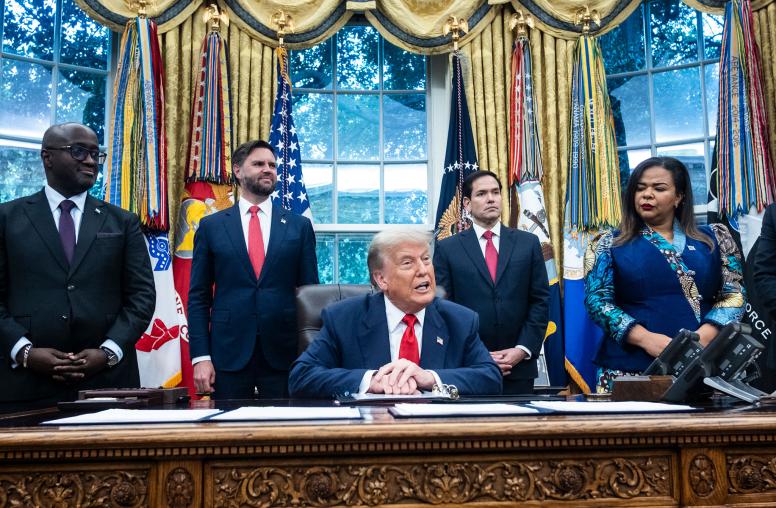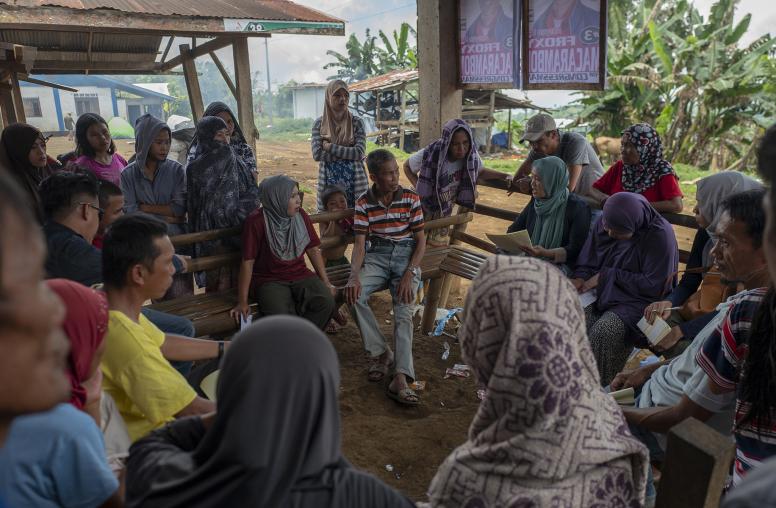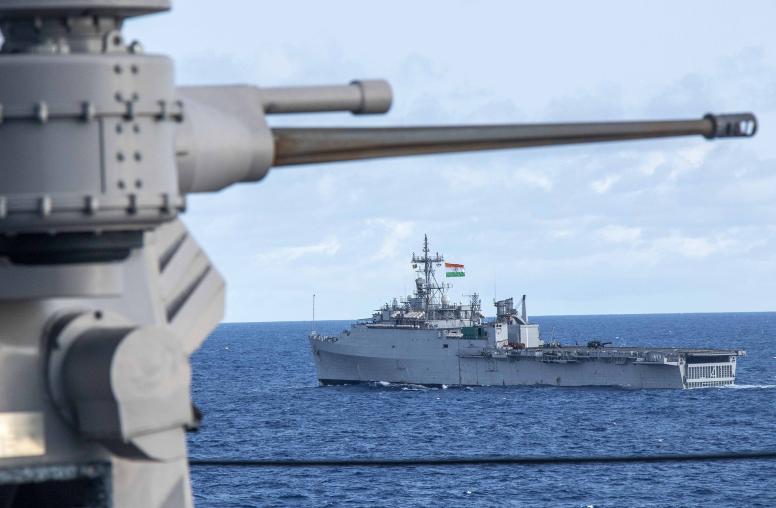2005-2006 Winning Essay
National First Place Winner
Kona L. Shen
The Northwest School
Seattle, Washington
Coordinator: Mr. Jeff Blair
Since the dawn of the nuclear age and the subsequent onset of the Cold War, tense arms races have swept the world, threatening global security. Many nations, however, have recognized the danger of global proliferation and chosen to dismantle their nuclear programs.1 While countries such as Brazil and Argentina have dismantled their programs rapidly and successfully, other nuclear states—such as India and Pakistan—have been unable to defuse their strained relations and remain nuclear competitors. These two situations reveal that disarmament is most successful when the international community supports—rather than interferes with—bilateral collaboration and, most importantly, when the decision to disarm is primarily autonomous and self-motivated.
Though the strained relations between Brazil and Argentina peaked in the late 1970s, the "rivalry and subtle tensions between the two countries can be traced back to colonial days."2 As Brazil gained international recognition in the 20th century, Argentina accelerated its nuclear program in an effort to check its rival's burgeoning power. Argentina's nuclear program advanced quickly and "by the early 1980s was thought to be about five years ahead of Brazil in having the capability to produce material suitable for a nuclear weapon."3 Recognizing Argentina as a viable threat, Brazil consequently increased its nuclear capabilities; the nationalism and rivalry between the two Latin nations had become an essential part of the countries' nuclear arsenals.
The world supported the nuclear programs of Brazil and Argentina by providing supplies and assistance. In the 1940s, Brazil's nuclear program was advanced when the United States agreed to give Brazil technological information on nuclear arms in exchange for mining rights.4 By the mid-1950s the United States "retained ultimate control over the processes" of Brazil's "Atoms for Peace" program and oversaw its extraction of uranium. It wasn't until 1975 that Brazil would boldly assert its autonomy by announcing it would henceforth receive its nuclear technology from West Germany, not the United States.5
As a result of Brazil's 1973 petroleum crisis, Ernesto Geisel, the newly elected president, began to redirect the country's nuclear program to address its energy needs.6 It was "with the arrival of democratically elected regimes in the 1980s...that significant progress toward cooperation began to be made"7 as these programs were accelerated. In Argentina, President Raul Alfonsin handed over the country's nuclear program to civilian control and introduced legislation "to legally prohibit development of nuclear weapons." By choosing to disengage from the arms race in order to address internal problems—a choice supported by civilians in both countries—Brazil and Argentina were at last able to pursue disarmament.
In 1980, the historic Brazilian-Argentine Agreement on the Peaceful Use of Nuclear Energy established "technical cooperation and coordination of civilian nuclear policy."9 A string of treaties followed, which emphasized the importance of mutual transparency between the two countries' nuclear programs and allowed the two countries to inspect each other's nuclear power plants—even those to which the International Atomic Energy Agency did not have access.10 By the end of the 1990s, both Brazil and Argentina had ratified the Treaty of Tlatelolco, which created the Latin American Nuclear Weapons Free Zone, and the Nuclear Non-Proliferation Treaty. At last, they had concluded a "series of agreements that defused the nuclear rivalry between the two countries and committed both to exclusively peaceful use of nuclear technology."11
Across the world, in South Asia, India and Pakistan have been involved in a nuclear arms race that has outlasted the Cold War. The rivalry between these two countries dates back to their partition in 1947, and their conflicts have been more volatile and their negotiations less flexible than those of Brazil and Argentina.12 Throughout the 20th century, both India and Pakistan were manipulated by the international community, and neither country has achieved independence from manipulative pressures in order to successfully disarm and achieve peace in the region.
India's motivation to develop nuclear weapons stemmed from its wish to protect itself from bordering countries, as well as its desire to assert itself as a major world power. Since the mid-1950s, India has been threatened by its neighbors Pakistan and China. China detonated its first nuclear bomb in October 1964, and—not coincidentally—India was the next country to follow, in May 1974. Pakistan began developing a nuclear bomb in 1972 in order to compete with and protect itself from India's military capabilities. In the years that followed, tensions escalated, and by the 1980s, the two countries were competing in an arms race that created widespread fear of nuclear Armageddon. These fears seemed justified when, in 1998, India detonated "a peaceful nuclear device" underground and Pakistan reacted quickly, detonating its own underground nuclear bombs just months later.13
Up until the 1990s, the United States chose to support Pakistan while the USSR allied with India, demonstrating how relentlessly Cold War politics exacerbated the situation.14 China contributed to the problem by providing Pakistan with supplies for its nuclear program and arming the other countries that border India.15 During this time, not only did powerful nations not actively support nonproliferation between India and Pakistan, they worsened it by manipulating the situation for their own purposes.
Unlike South Asia, South America was not considered a crucial region by either the Americans or the Soviets.16 In retrospect, it is clear that this was a key reason why Brazil and Argentina never reached the level of political and nuclear tension that India and Pakistan currently sustain. Unlike India and Pakistan, countries in Latin America were never deliberately pitted against each other in order to provide another country an advantage.
Since the conclusion of the Cold War, the goals of the international community have shifted, and the disarmament of India and Pakistan has become a priority.17 However, the process has been frustratingly slow, largely due to a lack of stability within both countries, as well as the unwillingness—especially on India's part—to risk vulnerability in the peace process. Because of the sensitive history of conflict between the two nations, they are intensely defensive when dealing with one another, unlike Brazil and Argentina, who were significantly more willing to resolve their differences.
In recent years, tensions between India and Pakistan have eased slightly, creating opportunities to de-escalate the situation. Pakistan has approached India with proposals to create a nuclear-free zone in South Asia, to disarm and sign the Non-Proliferation Treaty, and to participate in regional conferences on non-proliferation. However, threatened by China's aggressive nuclear program, India has declined. The only progress that has been made includes a "no first use" agreement and an agreement to support the Comprehensive Test Ban Treaty, which, though encouraging, is not enough to lead to disarmament.18
As long as India continues to feel threatened by China, it seems unlikely that an agreement will be reached with Pakistan. Even now, India is suspected of developing nuclear missiles that could reach China's industrial heartland, and Pakistan is known to possess weapons that could reach Madras, on the southeastern coast of India.19 Though India still considers nuclear weapons to be a "cost-effective political counter to China's nuclear program,"20 it has suggested that it is open to signing a revised version of the Nuclear Nonproliferation Treaty, one that requires the five declared nuclear states to decrease their arsenals.21
The controversy over the nuclear states' arsenals provides the five states with an opportunity to increase non-proliferation efforts by leading through example. It is the duty of these states to demonstrate the feasibility of disarmament by downsizing their own nuclear programs. The United States alone still has 10,000 warheads and is planning to rebuild nuclear manufacturing plants that have been closed since the end of the Cold War. 22 Neither policy supports non-proliferation.
Countries that have disarmed successfully, such as Brazil and Argentina, are also powerful advocates for nonproliferation because they are able to demonstrate that nuclear arms are not an essential part of national security. Furthermore, all countries must refrain from undermining international treaties by demanding special privileges. The double standards that such nations as the United States cling to create distrust among all members of the international community and destabilize non-proliferation efforts.23
As the disarmament movement continues to work towards international non-proliferation, it will be necessary to establish conditions in which nuclear states will be able to reach peaceful agreements. As Brazil and Argentina demonstrated, it is necessary for the autonomy of the nations involved to be supported. As the world considers how to resolve the conflict between India and Pakistan, it must realize that neither bilateral agreements nor international treaties will suffice without the other. Countries must actively strengthen the treaties by improving their own nuclear policies and reducing their own nuclear arsenals. It is only with the complete cooperation of all nations that our society will be able to progress towards complete nonproliferation, resulting in an increased level of global security that will benefit all members of the international community.
Endnotes
1. Grahm Jr., Thomas. Disarmament Sketches: Three Decades of Arms Control and International Law. Seattle: University of Washington Press, 2002, p. 313-34.
2. Selcher, Wayne A. "Brazilian-Argentine Relations in the 1980s: From Wary Rivalry to Friendly Competition." Journal of Interamerican Studies and World Affairs. 1985: 25-53. JSTOR. The Northwest School, Library, Seattle. 25 January 2006 http://www.jstor.org/search.
3. Jones, Rodney W., Mark G. McDonough, Toby F. Dalton and Gregory D. Koblentz. "Argentina." Carnegie Endowment for International Peace. 1998. Carnegie Endowment for International Peace. 24 January 2006 http://www.ceip.org/programs/npp/nppargn.htm.
4."Country Profiles: Argentina and Brazil." Disarmament and Peace Education. 27 Feb. 2002. Global Security Institute. 23 Jan. 2006 http://www.gsinstitute.org/dpe/countries/argentina_brazil.html.
5. "Nuclear Weapons Programs." Weapons of Mass Destruction Around the World. 6 Oct. 1999. Federation of American Scientists. 25 Jan. 2006 http://fas.org/nuke/guide/brazil/nuke.
6. Ibid
7. Jones, Rodney W., et als. "Argentina."
8. "Country Profiles: Argentina and Brazil."
9. Ibid
10. Jones, Rodney W., et als. "Argentina."
11. "Country Profiles: Argentina and Brazil."
12. Bidwai, Praful and Achin Vanaik. New Nukes: India, Pakistan and Global Nuclear Disarmament. Northampton: Interlink Publishing, 2000, p. 112-113.
13. Ibid.
14. "India Foreign Relations." India Guide and Resource Information. 2000. Indian Child. 23 Jan. 2006 http://www.indianchild.com/india.htm.
15. "Pakistan Nuclear Weapons." Weapons of Mass Destruction Around the World. 11 Dec. 2002. Federation of American Scientists. 21 Jan. 2006. http://www.fas.org/nuke/guide/pakistan/nuke/.
16. "Latin America after World War II." Cold War in Latin America. Shannon L. Duffy, Ph.D. 25 Jan. 2006. http://www.loyno.edu/~seduffy/coldwarlatinam.html.
17. Bidwai, Praful et al. New Nukes: India, Pakistan and Global Nuclear Disarmament.
18. Ibid.
19. Ibid.
20. "Nuclear Power in India and Pakistan." Nuclear Issues Briefing Paper 45. Oct. 2005. Uranium Information Centre. 27 Jan. 2006 http://www.uic.com.au/nip45.htm.
21. Ibid
22. Sterngold, James. "Upgrades Planned for U.S. Nuclear Stockpile; Agency Leader Expects Significant Warhead Redesigns." San Francisco Chronicle. 15 Jan. 2006. SFGate.com. 22 Jan. 2006 http://www.sfgate.com/cgi-bin/article.cgi?file=/c/a/2006/01/15/MNGTTGNL5P1.DTL.
23. "Weak Prospects for Nuclear Nonproliferation Efforts." By Daniel Schorr. All Things Considered. National Public Radio. KUOW, Seattle. 2 May, 2005. "Countries Review Nuclear Nonproliferation Treaty." By Michele Kelemen. All Things Considered. National Public Radio. KUOW, Seattle. 2 May, 2005.
Bibliography
Works Cited:
Aizenstat, A.J. Survival for All: The Alternative to Nuclear War with a Practical Plan for Total Denuclearization. New York: Billner & Rouse Inc., 1985.
Bidwai, Praful and Achin Vanaik. New Nukes: India, Pakistan and Global Nuclear Disarmament. Northampton: Interlink Publishing, 2000.
Cheney, Glenn Alan. Nuclear Proliferation: The Problems and Possibilities. New York: Grolier Publishing, 1999.
"Countries Review Nuclear Nonproliferation Treaty." By Michele Kelemen. All Things Considered. National Public Radio. KUOW, Seattle. 2 May, 2005.
Grahm Jr., Thomas. Disarmament Sketches: Three Decades of Arms Control and International Law. Seattle: University of Washington Press, 2002.
Maddox, Robert James. Weapons for Victory: The Hiroshima Decision Fifty Years Later. Columbia: University of Missouri Press, 1995.
Roussopoulos, Dimitrios I. The Coming of World War Three: From Protest to Resistance/the International War System (Volume 1). Buffalo: Black Rose Books, 1986.
Schell, Jonathan. The Gift of Time: The Case for Abolishing Nuclear Weapons Now. New York: Metropolitan Books, 1998.
"Weak Prospects for Nuclear Nonproliferation Efforts." By Daniel Schorr. All Things Considered. National Public Radio. KUOW, Seattle. 2 May, 2005.
Internet Sources:
"Country Profiles: Argentina and Brazil." Disarmament and Peace Education. 27 Feb. 2002. Global Security Institute. 23 Jan. 2006 http://www.gsinstitute.org/dpe/countries/argentina_brazil.html.
"Ending Further Production: Fissile Material Cutoff Treaty." Nuclear Threat Initiative: Working for a Safer World. 11 Aug. 2004. Nuclear Threat Initiative. 20 Jan. 2006 http://www.nti.org/e_research/cnwm/ending/fmct.asp.
"India Foreign Relations." India Guide and Resource Information. 2000. Indian Child. 23 Jan. 2006 http://www.indianchild.com/india.htm.
Jones, Rodney W., Mark G. McDonough, Toby F. Dalton and Gregory D. Koblentz. "Argentina." Carnegie Endowment for International Peace. 1998. Carnegie Endowment for International Peace. 24 January 2006 http://www.ceip.org/programs/npp/nppargn.htm.
"Latin America after World War II." Cold War in Latin America. Shannon L. Duffy, Ph.D. 25 Jan. 2006. http://www.loyno.edu/~seduffy/coldwarlatinam.html.
"Nuclear Power in India and Pakistan." Nuclear Issues Briefing Paper 45. Oct. 2005. Uranium Information Centre. 27 Jan. 2006 http://www.uic.com.au/nip45.htm.
"Nuclear Weapons Programs." Weapons of Mass Destruction (WMD). 28 Apr. 2005. Global Security. 24 Jan. 2006 http://www.globalsecurity.org/wmd/world/brazil/nuke.htm.
"Nuclear Weapons Programs." Weapons of Mass Destruction Around the World. 6 Oct. 1999. Federation of American Scientists. 25 Jan. 2006 http://fas.org/nuke/guide/brazil/nuke.
"Pakistan Nuclear Weapons." Weapons of Mass Destruction Around the World. 11 Dec. 2002. Federation of American Scientists. 21 Jan. 2006. http://www.fas.org/nuke/guide/pakistan/nuke/.
Selcher, Wayne A. "Brazilian-Argentine Relations in the 1980s: From Wary Rivalry to Friendly Competition." Journal of Interamerican Studies and World Affairs. 1985: 25-53. JSTOR. The Northwest School, Library, Seattle. 25 Jan. 2006 http://www.jstor.org/search.
Sterngold, James. "Upgrades Planned for U.S. Nuclear Stockpile; Agency Leader Expects Significant Warhead Redesigns." San Francisco Chronicle. 15 Jan. 2006. SFGate.com. 22 Jan. 2006 http://www.sfgate.com/cgi-bin/article.cgi?file=/c/a/2006/01/15/MNGTTGNL5P1.DTL.
"The Nuclear Weapon Archive." A Guide to Nuclear Weapons. 9 Aug. 2001. The Nuclear Weapon Archive. 22 Jan. 2006. http://nuclearweaponarchive.org.




